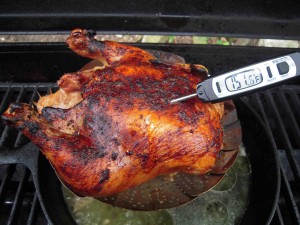It’s the one recipe to which even rudimentary cooks like to add their unique touches – perhaps a herby garnish or a few strips of bacon.
 But it seems the days of roast chicken prepared in the distinctive way that your family has always enjoyed it may be numbered (the bird, right, was cooked to excess of 165F before serving).
But it seems the days of roast chicken prepared in the distinctive way that your family has always enjoyed it may be numbered (the bird, right, was cooked to excess of 165F before serving).
Supermarkets are, according to Valerie Ellliot of the Daily Mail, urging shoppers to buy chickens in sealed ready- to-roast bags, amid fears that people are no longer able to maintain basic kitchen hygiene.
The aim is to reduce the number of campylobacter food-poisoning cases caused by handling fresh birds.
Supermarkets are increasingly promoting chickens in roast bags that are opened only after cooking. There is no human contact with raw skin and a lower risk of poultry juices spreading bugs. In most cases, they are marginally more expensive – Tesco charges £6 for a 3.3lb bagged version against £5 for a plain chicken.
Asda launched roast-in-bag flavoured chickens in September last year. Six million have been sold, and they now make up 30 per cent of all its chicken sales. A turkey crown in a bag will be on sale for Christmas.
Marks and Spencer now sells two thirds of its chickens in bags and they are also sold at Sainsbury’s, Waitrose and Aldi, while Morrisons and Lidl intend to introduce them.
Restaurateur Mark Hix, who specialises in British cuisine, said: ‘I don’t think people should buy chickens in bags. That removes all the pleasure of cooking. Good hygiene is not difficult.’
 Good hygiene is difficult – it requires people to pay attention.
Good hygiene is difficult – it requires people to pay attention.
But it can be done. Just stop saying it’s simple.
Tom Parker Bowles, Mail on Sunday food critic asked, “has it really come to this? A nation so lacking in basic common sense that we’re not to be trusted to wash our own hands? A country so obsessed with ease and convenience that the birds we put in our ovens must be sanitized and shoved in a plastic bag?
“I’ve been cooking roast chicken for more than 20 years and have never once caught any nefarious bug. We all know that raw chicken is to be treated with care: separate chopping board, hands scrubbed with soap and all the rest.”
Yes, the ole’ I’ve-been-doing-it-this-way-all-my-life-and-never-got-sick line.
But people are getting sick.
A roast chicken is the cornerstone of any decent cook’s repertoire. I’m making one tonight, stuffed with 30 cloves of garlic, rosemary, sage, and other stuff, and then get to make stock for a couple of days (I’ve got a bunch of mushrooms to use, so I see a mushroom soup in the near future.
Maybe in addition to cooking food in plastic, which may have a role, there is a learning moment to talk about the prevalence of dangerous bugs and how they can best be controlled. And that involves using a tip-sensitive digital thermometer, not pedantic piping hot advice.


.jpg) journalists find related stories to fill the void.
journalists find related stories to fill the void.(2).jpg) Mike Doyle, a microbiologist who directs the Center for Food Safety at the University of Georgia, told
Mike Doyle, a microbiologist who directs the Center for Food Safety at the University of Georgia, told  "I’ve been avoiding bagged lettuce for years. I’ve been concerned about this for some time."
"I’ve been avoiding bagged lettuce for years. I’ve been concerned about this for some time."